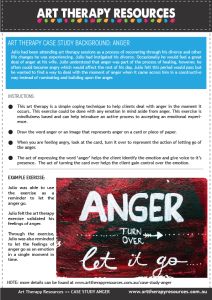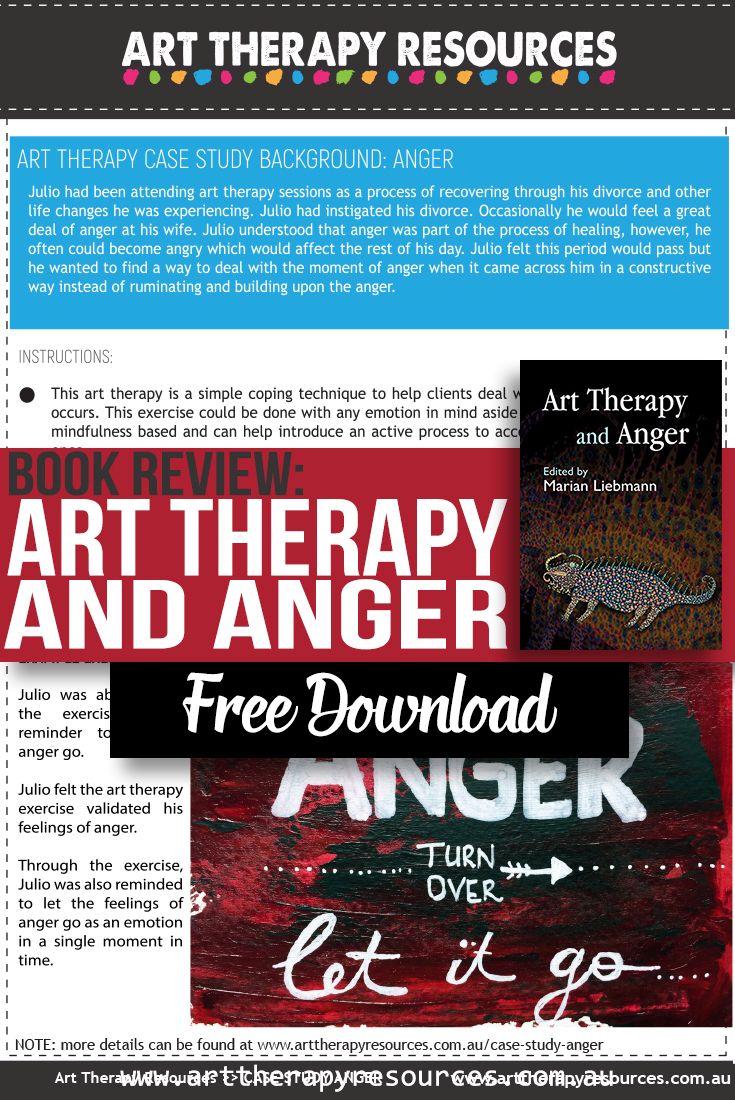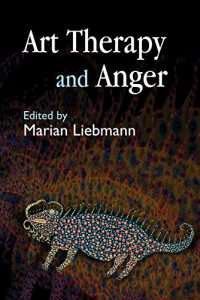THIS POST INCLUDES:
1. Art Therapy and Anger
2. The book review
3. FREE Download Case Study Exercise
Art Therapy and Anger
Author: Marian Liebmann (Author, Editor), Annette Coulter, Terri Coyle, Hilary Brosh, Maggie Ambridge, Sheila Knight, Susan Law, Sue Pittam, Leila Moules, Hannah Godfrey, Simon Hastilow, Camilla Hall, Susan Hogan, Elaine Holliday, Sally Weston, Kate Rothwell
Date published: 2008
Page length: 282
Contents: 15 chapters in total
Amazon purchase link: Art Therapy and Anger
Goodreads link: Art Therapy and Anger
ABOUT THE BOOK
Art Therapy and Anger demonstrates how the non-verbal medium of art therapy provides an ideal outlet for the expression of thoughts and feelings that are too complex and painful to put into words, presenting a new and practical approach to dealing with this area of need.
Marian Liebmann argues that clients of all ages will benefit from the art-making process, which helps them to slow down and consider their emotions more calmly. The tangible product of their efforts allows clients to assess and react to what they have depicted, providing a lucid and safe framework for better understanding the causes and effects of their anger.
This book draws together contributions from art therapists who work in a wide variety of contexts, including work with offenders, mental health clients, clients with brain injury, and those with cancer, with the view of helping clients to manage their anger more constructively.
This positive, practical volume will be of great interest to art therapists and students, as well as practitioners working with angry clients in various fields such as mental health, probation, counselling and medicine.
Book Content:
Part I: Children
1. The Anger of Abused Children
2. Anger Management with Children and Young People: Creative Tools to Mend Broken Tempers
3. When Love is Absent, Anger Fills the Void: Children in Foster Care
4. Anger and Danger: Adolescents and Self-harm
Part II: Offenders
5. Inside-Out/Outside-In: Art Therapy with Young Male Offenders in Prison
6. Androcles and the Lion: Prolific Offenders on Probation
7. What Anger? Working with Acting-out Behaviour in a Secure Setting
8. Avoided Anger: Art and Music Therapy in a Medium-secure Setting
Part III: Mental Health
9. The Role of Anger in Women who Cope by Self-harming
10. Art Therapy with Cognitive Behavioural Therapy in Adult Mental Health
11. Working on Anger Issues with a Deaf Client
Part IV: Other Client Groups
12. Angry Mothers
13. Art Therapy and Anger after Brain Injury
14. Not Being Calm: Art Therapy and Cancer
15. ‘Came Back – Didn’t Come Home’: Returning from a War Zone
A REVIEW OF ART THERAPY AND ANGER
Art therapy is one avenue that provides a space to express anger. The canvas, paper, or whatever substrate the individual chooses, can become the container to hold the expression of anger.
The editor, Marian Liebmann, acknowledges there are a variety of views about anger and whether it is classified as a destructive emotion to be ‘managed’ or whether it is a constructive emotion to be embraced and expressed. The editor states that the book expresses a diversity of views throughout the chapter. This is supported by the fact that all chapters are written by individual authors with specific expertise in their area.
The editor offers the below potential benefits of using art therapy to work with anger:
- art therapy is a method of communication for those who find it difficult to verbally articulate why they get angry
- doing the artwork slows clients down and enables them to engage in reflection on situations and experiences in their life
- art is a non-threatening and safe way to approach difficult issues
- art therapy can help link creative processes with language and long-term memory which can facilitate learning processes
- the art therapy session can provide a space to express feelings of rage in a safe environment that doesn’t further impact the individual by ‘losing control’
- art allows for the individual to express all thoughts and feelings that may appear contradictory
- art provides a tangible result of emotional expression that enables the individual to observe their thoughts and emotion
- art has no rules and therefore provides relief from the pressures of goal-oriented therapies.
- creating art as part of a group can facilitate group cohesion where individuals realise the things they have in common with each other
Liebmann also mentions there is controversy amongst art therapists over whether directive or non-directive work is the best approach to take. The book contains ideas from individual writers that mostly follow a non-directive approach, however, a few use a directive approach (specifically ch. 10 and 11. Some art therapists also use a mix based on the needs of the client. These are most obvious in chapters 1, 14, and 15.
The book shows over 60 examples of art created.
The book benefits from Marian’s excellent summary of how art therapy can be best used when working with anger issues. Given the complexity of anger as an emotion, it’s also refreshing to read the various points of view of other therapists who provide an insight into a specific issue where they hold expertise.
Purchase: If this book sounds interesting to you, it can be purchased from Amazon. You can also view the contents pages and a few of the introductory chapters in the sample. Amazon purchase link: https://amzn.to/3BREdRa
ART THERAPY EXERCISE

We have included a previously published Case Study focusing on Anger.
This art therapy exercise is a simple coping technique to help clients deal with anger in the moment it occurs. This exercise could be done with any emotion in mind aside from anger. This exercise is mindfulness-based and can help introduce an active process to accepting an emotional experience.
INSTRUCTIONS:
- Draw the word anger or an image that represents anger on a card or piece of paper.
- When you are feeling angry, look at the card, turn it over to represent the action of letting go of the anger.
- The act of expressing the word ‘anger’ helps the client identify the emotion and give voice to its presence.
- The act of turning the card over helps the client gain control over the emotion.
You can read more about the Case Study: Using Art Therapy for a Client with Anger
FREE DOWNLOAD: Art Therapy Exercise

BUILD YOUR ART THERAPY REFERENCE MATERIALS:
Pin this image to your Pinterest board.

SHARE KNOWLEDGE & PASS IT ON:
If you’ve enjoyed this post, please share it on Facebook, Twitter, Pinterest. Thank you!

